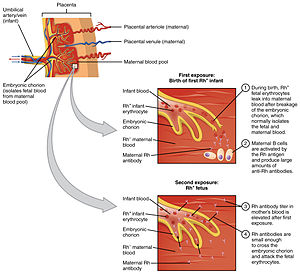Hemolytic disease of the newborn
| HDN | |
|---|---|
 |
|
| Classification and external resources | |
| Specialty | pediatrics |
| ICD-10 | P55 |
| ICD-9-CM | 773 |
| DiseasesDB | 5545 |
| MedlinePlus | 001298 |
| eMedicine | ped/959 |
| Patient UK | Hemolytic disease of the newborn |
| MeSH | D004899 |
Hemolytic disease of the newborn, also known as hemolytic disease of the fetus and newborn, HDN, HDFN, or erythroblastosis fetalis, is an alloimmune condition that develops in a fetus, when the IgG molecules (one of the five main types of antibodies) produced by the mother pass through the placenta. Among these antibodies are some which attack antigens on the red blood cells in the fetal circulation, breaking down and destroying the cells (hemolysis). The fetus can develop reticulocytosis and anemia. This fetal disease ranges from mild to very severe, and fetal death from heart failure (hydrops fetalis) can occur. When the disease is moderate or severe, many erythroblasts (immature red blood cells) are present in the fetal blood, and so these forms of the disease can be called erythroblastosis fetalis (or erythroblastosis foetalis).
HDFN represents a breach of immune privilege for the fetus or some other form of impairment of the immune tolerance of pregnancy. Various types of HDFN are classified by which alloantigen provokes the response. In order of incidence, the types include ABO, anti-RhD, anti-RhE, anti-Rhc, anti-Rhe, anti-RhC, multiantigen combinations, and anti-Kell.
...
Wikipedia
